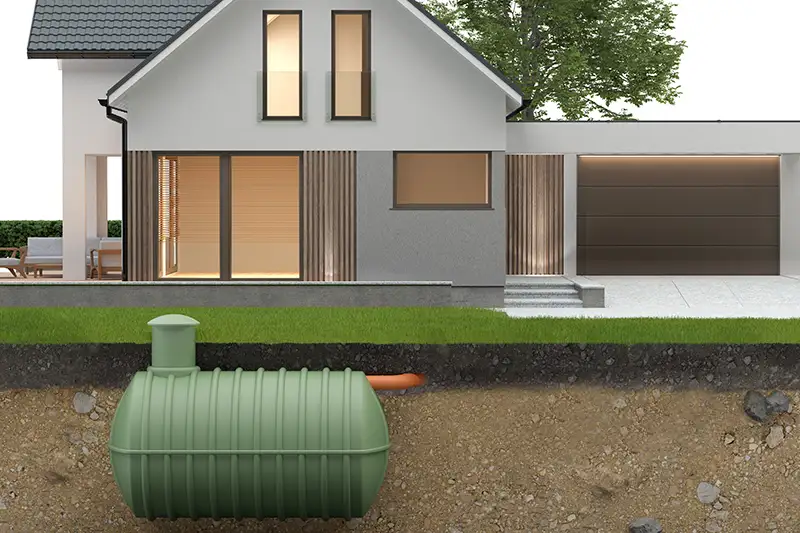
What happens after you run the sink or flush the toilet in your home? Many homeowners don’t give it a second thought, but if you have a septic system, you know a lot is going on beneath the surface. At their core, septic systems are designed to collect, process, and safely dispose of wastewater into the environment, but they go about it in different ways. So we wanted to take a moment to discuss common types of septic systems and how they work.
From gravity-powered designs to high-tech aerobic treatment units, understanding these systems is essential for choosing the right one and keeping it running smoothly.
How Does a Septic Tank Work?
Whether from the kitchen sink or the toilet, with most septic systems everything first flows into the septic tank. As the first stage in the process, this often buried watertight container plays a crucial role in managing and preparing wastewater for what comes next.
- The Arrival: Everything from flushed toilets, drained sinks, and washing machines flows into the septic tank.
- The Separation: Inside the tank, gravity takes over. Solids sink to the bottom, forming sludge, while oils and grease float to the top as scum. In the middle is the effluent—relatively clear water ready for further treatment.
- The Breakdown: Bacteria in the tank work on breaking down organic material, reducing the volume of solids over time.
- The Exit: Once separation is complete, the effluent exits the tank and moves to the next phase, whether that’s a drain field, treatment unit, or an alternative system.
What Are the Most Common Septic Tank Systems?
Every septic system has one goal: safely manage wastewater. How it achieves that depends on the type of system. Here are three of the most common systems you’ll find in King County:
Drip Distribution Septic System
The drip distribution system is an excellent choice for properties with tricky soil or limited space. After leaving the septic tank, the effluent is filtered and distributed through small tubing buried just under the surface.
The key feature? It delivers treated wastewater in small, precise doses to maximize absorption. This system requires an additional pump tank to ensure consistent flow, but it’s worth it for properties where conventional systems might overwhelm the surrounding environment.
Gravity Septic System
As its name suggests, the gravity system relies on the natural pull of gravity to do its job. Effluent flows from the septic tank into a network of trenches or drain lines buried in the soil. The soil acts as a natural filter, breaking down harmful bacteria and nutrients as the water slowly seeps back into the ground.
Gravity systems are a classic choice for properties with the right soil and topography – simple, effective, and low maintenance. To build an effective gravity system on your property, you’ll need an appropriately sized hill or mound where it can be located.
Aerobic Treatment Units (ATUs)
Unlike conventional systems, these units use oxygen to break down organic matter more efficiently. After the septic tank, wastewater moves into an aerobic treatment chamber where it’s infused with air. This process supports bacteria that work overtime to clean the effluent before it’s released into the environment.
While ATUs require electricity and regular maintenance, they offer a higher level of treatment, making them a great option for environmentally sensitive areas.
Choose Us for Your Septic Pumping Needs
Fill out our form and we'll be in touch!
Choose Us for Your Septic Pumping Needs
Fill out our form and we'll be in touch!
*During normal business hours. After hours calls will be returned the next business day.
Alternate Types of Septic Tank Systems
While less common in King County, here are a few more types of septic systems that are commonly used. For properties with unique challenges or specific needs, these can be a game-changer:
Sand Filter System
Think of this as a giant Brita filter for your wastewater. After the septic tank, effluent passes through a sand-filled container that filters out impurities. The treated water then goes to the drain field. It’s ideal for properties with shallow soil or high water tables.
Cluster System
Cluster systems are a shared septic solution for small communities and neighborhoods. Wastewater from multiple homes flows into a central treatment system before being discharged. While cost-effective for some developments, they require cooperation and shared responsibility among users.
Call Us for Septic System Maintenance and Pumping Services
No matter what type of septic system your property has, there’s one universal truth: regular maintenance is the key to keeping it running smoothly. And whether you’re dealing with a septic emergency or just need a routine pump-out, we’ve got you covered.
Puget Sound Septic is your local expert in all things septic. From drip distribution systems to aerobic treatment units and everything in between, we’ve seen it all – and we can help with yours. Call us today for reliable, professional septic services in King County, WA!
Back to Septic System InspectionCommon Types of Septic Systems and How They Work in Seattle WA
Serving King County WA
Maple Valley | Issaquah | Covington | Renton | East Renton Highlands | Black Diamond | Kent | Enumclaw
Bellevue | Sammamish | Fall City | Seatac | Burien | Federal Way | Palmer | Auburn | Ravensdale | Tukwilla | Beverly Park | Highline | North Bend | Redmond | Kirkland
Home » Septic System Inspection » Common Types of Septic Systems and How They Work
